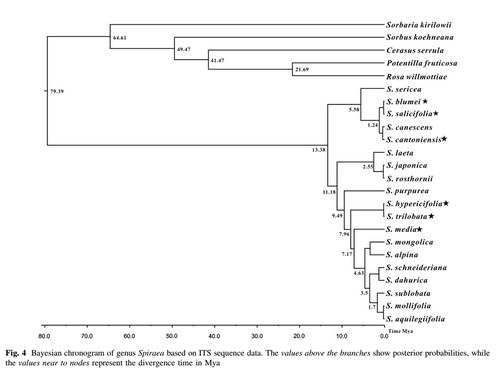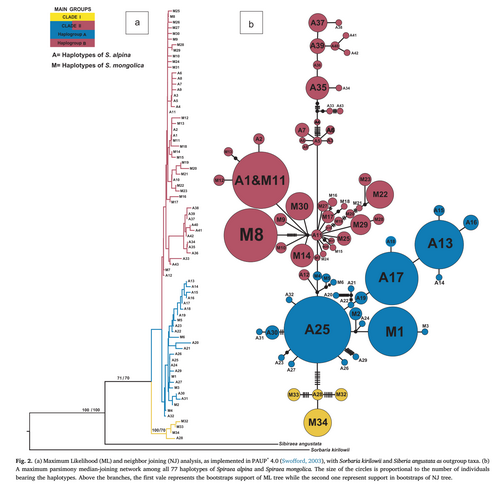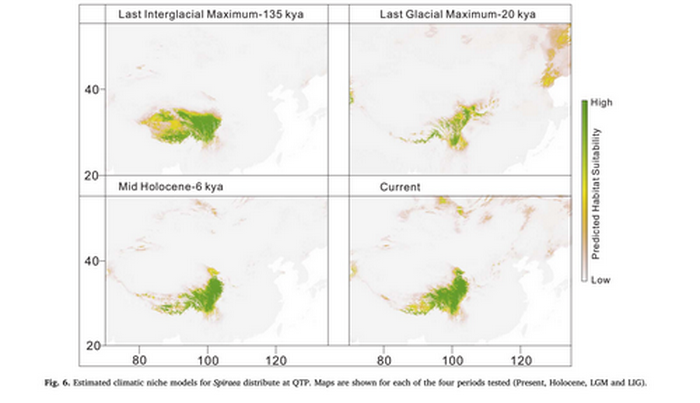青藏高原植物适应与进化学科组在绣线菊属进化历史研究中取得重要进展
青藏高原的隆升和形成一直决定着和影响着全球的生态格局和生态安全。同时,青藏高原也是全球生物多样性热点地区之一,分布有大量的特有种、特有属,是全世界极端环境生物遗传资源最丰富和密集的地区,因而是研究适应性进化、物种多样化、地质气候变迁对生物进化的影响与反馈等重大科学问题最为理想的地区。

绣线菊属Spriaea L.是绣线菊亚科,乃至蔷薇科中最原始的属,在系统进化过程中,衍生出形态各异而亲缘关系紧密的绣线菊种类。在我们之前的研究中发现,青藏高原地区的绣线菊属在第三纪中新世中期(13.38Mya)左右开始分化,正处于青藏高原的隆升的第一阶段。而该类群的快速分化的主要是由早上新世的高原隆升所致,第四纪的气候波动进一步加速了这一分化过程。为了进一步探究绣线菊属种内及近缘种间的物种分化过程,本研究组选择对青藏高原高山灌丛的主要建群种高山绣线菊Spiraera alpina及其近缘种蒙古绣线菊Spiraea mongolcia为研究对象,利用cpDNA、SSR及生态位模型分析等技术手段开展生物地理学研究。研究发现,第四纪气候波动造就了两种绣线菊较高的遗传多样性,两种绣线菊在末次盛冰期时退缩至高原东南部,而在间冰期时又扩散至更高海拔的高原台面,正是这种收缩/扩散的循环往复,加之高原隆升共同造就了两种绣线菊的现今遗传分布式样。高原隆升及冰期气候波动是两个物种种间分化和种内居群间的主要原驱动因子。



该研究得到了国家自然科学基金(31400322;31110103911),青海省应用基础研究计划(2016-ZJ-761),科技部基础性工作专项(2013FY112100),以及山水自然中心澜沧江基金(201607006)等项目的支持。该研究成果以“Spiroides shrubs on Qinghai-Tibetan Plateau: Multilocus phylogeography and palaeodistributional reconstruction of Spiraea alpina and S. Mongolica (Rosaceae)”为题发表在进化生物学重要期刊Molecular Phylogenetics and Evolution(进化生物学2区;IF=4.419)上,西北高原所博士研究生Gulzar Khan为该论文的第一作者,陈世龙研究员和张发起副研究员为共同通讯作者。
Gulzar Khan, Faqi Zhang*, Qingbo Gao, Pengcheng Fu, Yu Zhang, Shilong Chen*. Spiroides shrubs on Qinghai-Tibetan Plateau: Multilocus phylogeography and palaeodistributional reconstruction of Spiraea alpina and S. Mongolica (Rosaceae). Molecular Phylogenetics and Evolution, 123:137-148, 2018.
Abstract: A common hypothesis for the rich biodiversity found in mountains is uplift-driven diversification. Using a multilocus approach, here we assessed the influence of Qinghai-Tibetan Plateau (QTP) uplift and fluctuating regional climate on genetic diversity of two sister spiroides shrubs, Spiraea alpina and S. mongolica. Combined with palaeodistributional reconstruction modelling, we investigated the current and past-predicted distribution of these species under different climatic episodes. The study demonstrated that continuous pulses of retreat and expansion during last glacial-interglacial episodes, combined with the uplifting of QTP shaped the current distribution of these species. All the populations showed high level of genetic diversity based on both cpDNA and SSR markers. The average gene diversity within populations based on cpDNA markers was 0.383?±?0.052 for S. alpina and 0.477?±?0.048 for S. mongolica. The observed and expected heterozygosities based on SSR for both Spiraea alpina and S. mongolicawere HE(0.72–0.90)/HO(0.35–0.78) and HE(0.77–0.92)/HO(0.47–0.77) respectively. Palaeodistributional reconstruction indicated species’ preferences at southeastern edge of the plateau during last glacial maximum, at higher altitude areas of QTP and range expansion to central plateau during the interglacial episodes. Assignment tests in STRUCTURE, discriminant analysis of principal coordinates and Immigrants analysis in GENECLASS based on nuclear SSR markers did not support the hypothesis of gene flow between both the species. However, maximum likelihood approach based on cpDNA showed sharing of haplotypes between both species.
https://www.sciencedirect.com/science/article/pii/S1055790317306097



 青公网安备 63010402000197号
青公网安备 63010402000197号